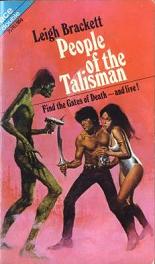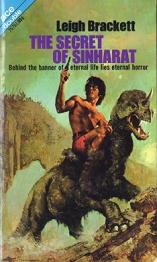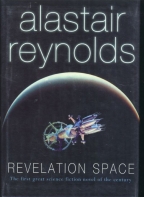China Miéville talks about his latest novel, in which he carefully explains the central conciet of The City and the City without spoiling what makes it unique.
science fiction
People of the Talisman – Leigh Brackett

The People of the Talisman
Leigh Brackett
126 pages
published in 1964
This is the flipside of the same Ace Double that also had The Secret of Sinharat, again starring Leigh Brackett’s greatest hero, Eric John Stark. It’s the longest of the two novels, a whole 126 pages long and a reworking of an earlier story Brackett wrote for the pulp magazine Planet Stories as Black Amazon of Mars. I found it to be slightly less immediately engaging as The Secret of Sinharat, but that’s only a minor quibble.
Interestingly enough, the opening of the story is the same as in the other tale: Eric John Stark is on the run from his enemies, but this time he’s with a friend, the thief Camar. They’re riding through the northern polar wastes of Mars attempting to reach Camar’s home city Kushat before he dies of his wounds. When it becomes clear he isn’t going to make it, he tells Stark of his secret shame, having stolen the Talisman that kept his city safe from the barbarian tribes roaming the wastelands and forces Stark to swear to return this talisman, which is hidden in Camar’s belt. Holding this belt to his head, Stark hears strange voices coming from it.
Imperial Earth – Arthur C. Clarke

Imperial Earth
Arthur C. Clarke
305 pages
published in 1976
The last Arthur C. Clarke book I’ve read was Rendezvous with Rama back in 2002; unfortunately it was the news of his death that brought me to read another, as a private homage. I had read Imperial Earth before, in Dutch, as Machtige Aarde and liked it, though it never became a favourite. It seemed a good idea to reread this rather than one of the more obvious classic Clarke novels, to get a good idea of the strengths of Clarke’s later works. Imperial Earth was written and published in 1976 and set three hundred years later, at the United States’ quincentennial, which to be honest immediately dates it for me. On the other hand it is refreshing to read a sf novel that has the US still existing three hundred years in the future, rather than as subsumed into a world government or fallen apart into a Balkanised mess. At the very least setting the book at the quincentennial signals how much of a seventies book this is.
Imperial Earth starts on Titan where despite the harsh circumstances a flourishing colony has been established, which makes its living supplying hydrogen for interplanetary fusion rockets as the only place in the Solar System where hydrogen was abundant enough to be worthwhile to harvest and gravity light enough to be able to do it cheaply. It was through the drive and will of one man, Malcolm Makenzie, that the Titan colony became a reality and he and his family have ruled it since. That same drive meant that when it became clear he suffered from too much gene damage due to space travel to produce children the normal way, he instead let himself be cloned on Earth. His son did the same and Duncan Makenzie is the second generation of Makenzies to be born this way, now old enough to do the same himself and fortuitiously invited to the quincentennial celebrations of the birth of America.
The Secret of Sinharat – Leigh Brackett

The Secret of Sinharat
Leigh Brackett
94 pages
published in 1964
Back when I was twelve I discovered a novel starring a brave Earthman transported to ancient Mars, a dying world of grand canals and encrouching deserts, populated by noble and barbarian races slowly sinking in decadence. I’m of course talking about Leigh Brackett’s pulp Mars stories rather than Edgar Rice Burroughs Barsoom series, which I never read until much later. But that Leigh Brackett novel was my first exposure to both Brackett and that grand pulp idea of a dying Mars filled with ancient secrets and half forgotten ruins of a greater past. To this day I still like Brackett better than Burroughs, not just I encountered her first, but because she’s the better writer.
If Leigh Brackett sounds familiar but you’re sure you’ve never read any of her stories, it might just be because you remember her name from the credits of The Empire Strikes Back, the second and best Star Wars novel. You see, apart from writing some of the best pulp science fiction ever, Brackett also had a long and distinguished career as a Hollywood script writer, working on such movies like The Big Sleep, Rio Bravo and The Long Goodbye. But it’s her science fantasy I like best.
Science fantasy is that subgenre of science fiction that has all the trappings of science fiction, –aliens, other planets, blasters and aircars — but which actually read a lot like sword and sorcery in disguise, with strapping barbarian heroes fighting degenerate warlocks using superscience of an earlier age that they barely understand. It’s very romantic, not very plausible or much concerned with realistic science. Science fiction in that grand pulp tradition of Edgar Rice Burroughs. And like Burroughs had his John Carter, Brackett has Eric John Stark, the outlaw with a twenty year Moonprison sentence on his head, raised by a strange non-human tribe on Mercury, (in)famous on three planets as a barbarian and renegade, but also as a man with his own code of honour.
Revelation Space – Alastair Reynolds
(I actually read this book way back in February 2004, but only now finished the review. Surely some kind of record?)

Revelation Space
Alastair Reynolds
614 pages
published in 2000
Alastair Reynolds’ is the Netherlands most famous science fiction writer –even if he is British. He works for the European Space Agency in Noordwijk and has lived here since 1991 you see, which may not make him Dutch but it sure means we’ll claim him as a writer. If Canada can claim everybody who has even flown over the country as one of their own, so can we. Revelation Space is his first novel; I’m not sure why I didn’t pick it up earlier. Reynolds started getting published in the early nineties, in Interzone and later became a regular in Gardner Dozois’ Year’s Best Science Fiction anthologies. It is therefore not a great surprise that his first novel is remarkably accomplished with none of the weaknesses of the typical first novel.
Revelation Space itself is an attempt to write semi-realistic Space Opera, without the miracle technology and artifacts of classic space opera, which mainly means no faster-than-light space travel. There’s still plenty of other, more “political correct” miracle technology on display though, like artificial intelligence, nanotech and handwaved quantum mechanic stardrives. Each of these technologies may be just as unlikely or be breaking as many laws of physics as FTL travel, but those haven’t been fetishised
as taboo, you see.